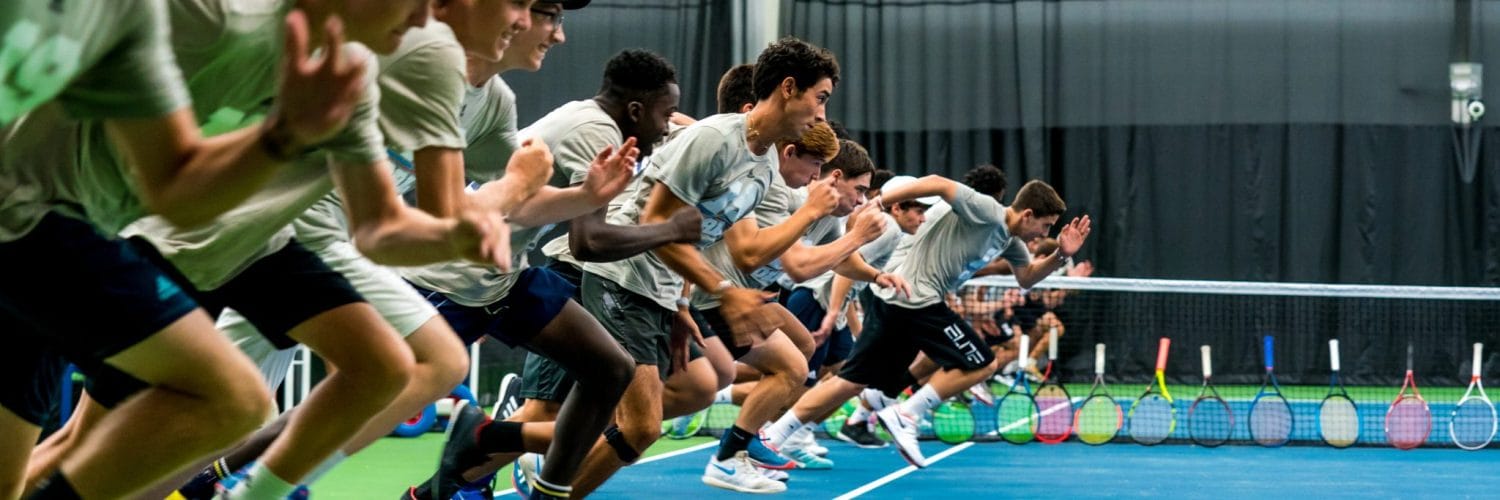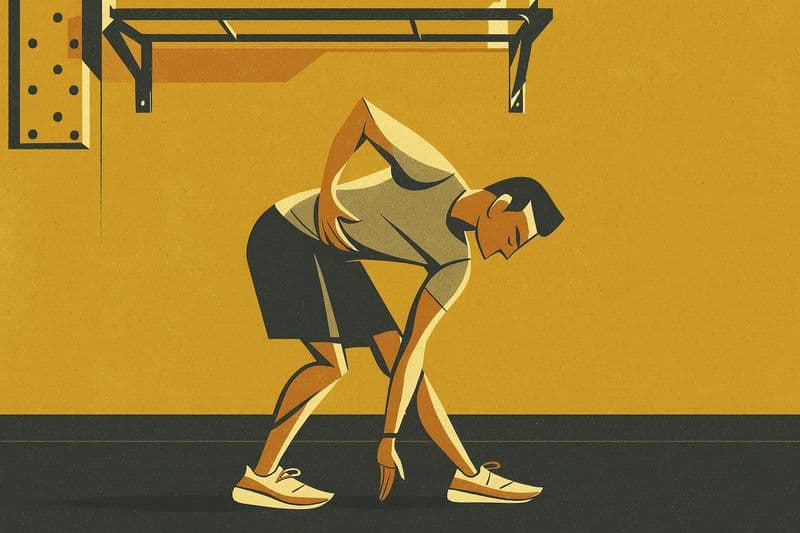
Introduction
Tennis demands stamina, quick movement, and agility. For beginners, improving endurance isn’t just about running laps - it’s about mastering drills that mimic real gameplay. Here’s a quick summary of five effective endurance drills for tennis beginners:
Running & Sprinting Drills: Improve explosive speed with sprint intervals and distance-based patterns.
Jump Rope Exercises: Boost footwork, balance, and coordination with basic and advanced jumping techniques.
Baseline Rally Practice: Build stamina and consistency with controlled, long-duration rallies.
Crosscourt Rally Practice: Enhance lateral movement and precision with crosscourt rally drills.
Fast Feet Drill: Sharpen footwork and agility with quick directional changes.
Each drill is designed to improve your stamina, balance, and on-court performance. Start with 15–20 minutes per session, 2–3 times a week, and gradually increase the intensity as your fitness improves. Let’s dive into the details.
Tennis Fitness Drills for Agility and Stamina
1. Running and Sprinting Drills
Running and sprinting drills are great for building stamina and preparing for the fast-paced movements required in tennis. These exercises not only improve your endurance but also help mimic the quick bursts of speed needed during a match.
Begin with a 5-10 minute light jog to warm up and reduce the risk of injury. After that, focus on sprint intervals tailored to tennis movements:
Basic Sprint Pattern: Sprint for 30 seconds, then walk for 90 seconds. Repeat this cycle for 10-15 minutes to improve explosive speed and recovery.
Distance-Based Training: Follow the table below to target different aspects of your sprinting ability:
Sprint Distance | Purpose | Sets |
|---|---|---|
5-10 meters | Quick acceleration | 6-8 |
15-20 meters | Speed maintenance | 4-6 |
35-45 meters | Full court coverage | 3-4 |
Tips for Better Performance
Keep your steps quick and light while staying in an athletic stance.
Pay attention to controlled breathing to maintain stamina.
To simulate tennis gameplay, include diagonal and baseline sprints in your routine. These movements improve balance and speed, crucial for on-court performance. Aim to do these drills 2-3 times a week, ensuring you have enough recovery time between sessions.
Once you've built a solid sprinting foundation, add agility exercises like jump rope drills to sharpen your footwork and boost endurance further.
2. Jump Rope Exercises
Jump rope exercises are a great way to build on the sprinting drills you've already practiced. These workouts target explosive power, footwork, and strength - key skills for tennis players.
Start with 1-3 minute intervals using techniques like:
Basic Bounce: Low, controlled jumps.
Running in Place: Alternate your feet as you jump.
Lateral Jumps: Move side-to-side to mimic tennis footwork.
Once you're comfortable, step it up with these variations:
Single-leg jumps: Do 30 seconds on each leg to improve balance.
Cross-arms jumps: Try 1 minute to boost coordination.
Lateral movements: Jump side-to-side for 45 seconds to practice court coverage.
Training Guidelines
Aim to practice 2-3 times a week on soft surfaces like grass or indoor courts to reduce strain on your joints. Always warm up with stretches and strength exercises before diving into intense jump rope sessions.
Key Safety Tips
Keep your posture upright.
Hold your elbows close to your body.
Take breaks often to avoid overworking yourself.
Jump rope drills are fantastic for building coordination, strengthening key muscles, and improving explosive movements on the court. Once you've nailed these exercises, you're ready to move on to rally-based drills that combine endurance with tennis-specific gameplay.
3. Baseline Rally Practice
Baseline rally practice is a great way to boost your endurance while honing the core skills needed for tennis matches. It combines stamina-building with technical improvement, making it especially useful for beginners.
Setting Up the Drill
Position yourself 1.5 to 2 meters behind the baseline. This gives you enough space to handle incoming shots effectively. Your partner should stand in the same position on the opposite side, ensuring both players can hit balls comfortably at knee height.
How to Run the Drill
Start with easy-paced rallies that last 5-10 minutes. The goal here isn’t power - focus on keeping your shots consistent and controlled. Aim cross-court for a larger target area, which helps maintain accuracy and rhythm.
Key points to remember:
Aim for consistent shots into wide target zones, then gradually work on smaller areas as your accuracy improves.
Always return to the baseline quickly after each shot to stay ready.
Adding a Challenge
As you improve, increase both the rally duration and the pace. At the same time, shrink the target zones to sharpen your precision.
Rally Duration & Speed | Target Zone |
|---|---|
5-10 minutes, steady pace | Full court |
10-15 minutes, moderate pace | 3/4 court |
15-20 minutes, match-level speed | 1/2 court |
Tips for Success
Take short 30-second breaks between rally sets to reset and stay sharp. Practice this drill 2-3 times a week, always starting with a proper warm-up. Use a relaxed, natural swing to conserve energy, allowing you to last longer during rallies while improving your technique.
For more personalized guidance, platforms like TeachMe.To can connect you with experienced tennis coaches who can help refine your baseline rally skills and build a solid foundation for your game.
Once you’ve nailed the basics of baseline rallies, you’re ready to explore crosscourt rally drills to further enhance your movement and strategy.
4. Crosscourt Rally Practice
Crosscourt rally practice takes your baseline rally skills to the next level by adding more lateral movement and focusing on match-play patterns. This drill is a great way to improve stamina while sharpening your technique, especially for beginners.
Setting Up
Start behind the baseline, just like in the baseline rally drill. Add visible targets to the court to help you focus on accuracy and precision.
Progressive Difficulty Levels
Duration | Target Area | Pace |
|---|---|---|
5-10 minutes | Center court | Slow |
10-15 minutes | Mid-court | Moderate |
15-20 minutes | Near tramlines | Fast |
Key Technical Tips
Pay attention to proper technique throughout the drill. Here are some key points to focus on:
Use your legs to generate power.
Keep your racquet in a ready position.
Maintain a relaxed grip to avoid unnecessary fatigue.
Stay balanced with consistent footwork.
Position your racquet early for each shot.
Aim to hit the ball at knee height or lower for better control.
Practice Guidelines
Practice this drill 2-3 times per week. Begin with 5-minute sets and gradually work up to 15-20 minutes as your endurance improves. Increase the challenge by moving the targets closer to the tramlines and maintaining control at faster speeds. Take 30-second breaks between sets to keep the quality of your practice high.
This drill is an excellent way to build both stamina and technique. The crosscourt pattern naturally involves more side-to-side movement compared to straight baseline rallies, giving you a solid workout while helping you prepare for match situations.
Once you're comfortable with crosscourt rallies, you can move on to footwork-focused drills to further enhance your agility and endurance.
5. Fast Feet Drill in Wide Stance
This drill builds on the lateral movement skills honed during crosscourt rallies. It sharpens tennis-specific footwork while boosting speed and endurance through quick directional changes.
Setup and Drill Structure
Begin in a wide, athletic stance similar to the ready position in tennis. Place your feet wider than shoulder-width apart, keep your knees slightly bent, and stay light on the balls of your feet.
Duration | Recovery | Sets |
|---|---|---|
30-60 seconds | 45-60 seconds | 2-3 per side |
Incorporate movements that progress from slow and controlled, to medium-paced shuffles, and then to quick, precise direction changes.
Key Details to Focus On
Keep your upper body steady while moving your feet quickly.
Add variations like split-steps, diagonal shuffles, and forward-backward movements to simulate match conditions.
Form and Technique Tips
Stay low in your stance throughout the drill. Avoid standing up straight, taking overly large steps, or losing your balance during quick changes. Controlled, sharp movements will help you get the most out of this exercise.
Training Goals
Perform this drill on a tennis court to replicate the movements you'll use in a real match. As you improve, gradually increase the duration and speed while keeping your footwork precise and balanced.
This drill is a great way to improve your agility, stamina, and overall readiness for the fast-paced demands of tennis.
Wrapping Up

Improving tennis endurance takes dedication and a well-planned approach. The five drills mentioned can help beginners build the stamina and strength needed to perform better on the court.
Start with 15-20 minute sessions for each drill and gradually increase the intensity and duration as your fitness improves. This step-by-step progression helps you avoid overtraining while steadily enhancing your endurance.
Here’s a simple guide to plan your training:
Training Phase | Duration | Weekly Sessions |
|---|---|---|
Initial | 15-20 minutes | 2-3 |
Intermediate | 25-35 minutes | 3-4 |
Advanced | 40-60 minutes | 4-5 |
Pay close attention to your form to reduce the risk of injury and develop proper muscle memory. Make sure to include enough recovery time between sessions to support steady progress. For personalized coaching, platforms like TeachMe.To can connect you with expert trainers who offer customized plans to meet your goals.
Stick with consistent practice, and you’ll not only build endurance but also be ready to handle the challenges of competitive tennis.
FAQs
How do tennis players build stamina?
Tennis players develop their stamina through a mix of targeted training methods. They focus on cardio workouts, strength exercises, agility drills, and flexibility routines to meet the sport's physical demands. If you're just starting, try basic drills like sprint intervals or jump rope, and gradually increase the intensity and duration to boost your endurance [1].
How can I improve my cardio for tennis?
To improve cardio for tennis, focus on exercises that replicate the sport's quick bursts of movement. Workouts like HIIT, jump rope, and circuit training are great for mimicking tennis's fast-paced, stop-and-go nature [1]. Beginners can start with a light 5-10 minute jog, then alternate 30-second sprints with 90-second walking intervals.
Here are some effective workout ideas:
Long-distance running: Build base endurance with 30-45 minutes of steady jogging.
Circuit training: Combine strength and cardio in 25-35 minute sessions.
Ladder drills: Improve footwork and agility with 15-20 minutes of ladder exercises.



